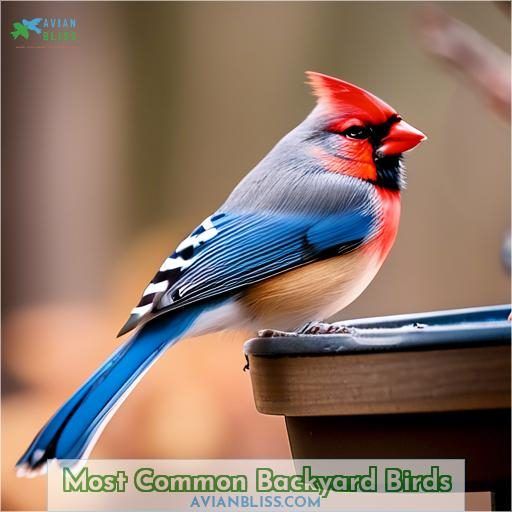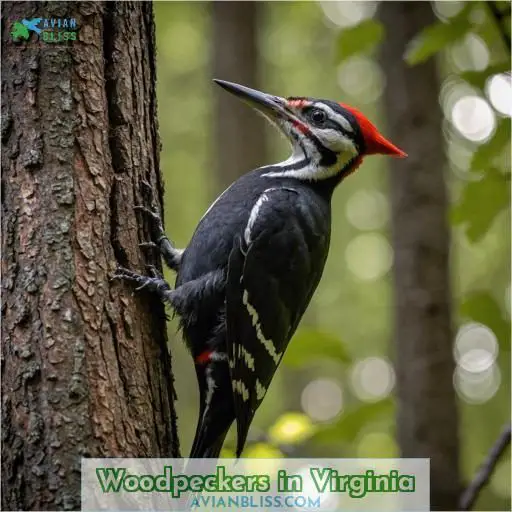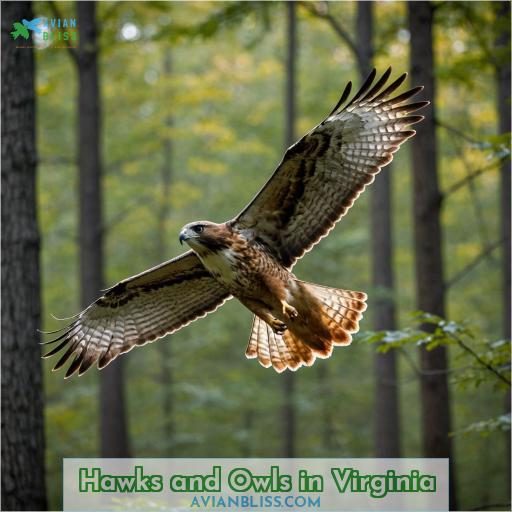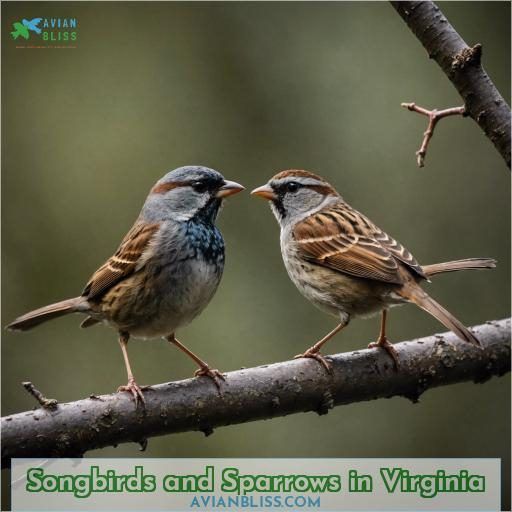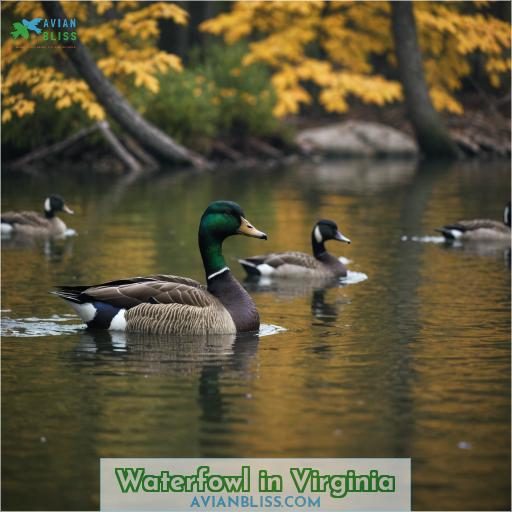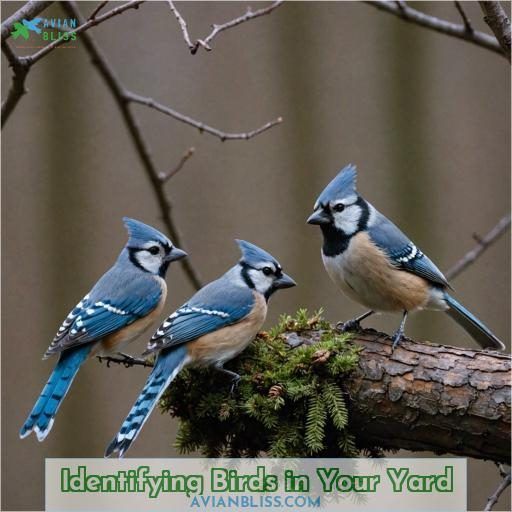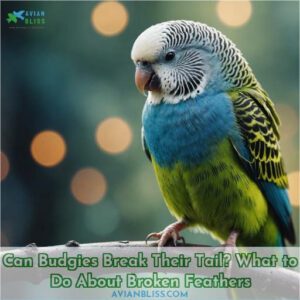This site is supported by our readers. We may earn a commission, at no cost to you, if you purchase through links.
 Virginia is home to a diverse array of common birds you’ll likely encounter in your backyard.
Virginia is home to a diverse array of common birds you’ll likely encounter in your backyard.
From the cheerful calls of the Carolina Chickadee and Tufted Titmouse to the bold colors of the Northern Cardinal and Blue Jay, these feathered friends offer a delightful symphony of sights and sounds.
Woodpeckers like the Downy and Red-bellied species drum on trees.
Raptors such as Red-tailed Hawks and Great Horned Owls soar overhead.
Songbirds like the Carolina Wren and Eastern Bluebird serenade with their melodious tunes.
Keep your eyes and ears open for these common birds in Virginia, and you’ll discover even more fascinating feathered residents.
Table Of Contents
- Key Takeaways
- Most Common Backyard Birds
- Woodpeckers in Virginia
- Hawks and Owls in Virginia
- Songbirds and Sparrows in Virginia
- Waterfowl in Virginia
- Identifying Birds in Your Yard
- Attracting Birds to Your Yard
- Protecting Birds in Virginia
- Migratory Birds in Virginia
- Rare and Endangered Birds in Virginia
- Frequently Asked Questions (FAQs)
- What is the most common bird in Virginia?
- What is the small gray bird in Virginia?
- How do I identify a bird in my yard?
- What is the most common wild birds?
- What is Virginias state bird?
- How many bird species are found in Virginia?
- What are some of the largest birds in Virginia?
- What is the fastest bird species found in Virginia?
- Which bird is the most commonly seen in Virginia backyards?
- Conclusion
Key Takeaways
- Virginia is home to a diverse array of common backyard birds, including the Carolina Chickadee, Tufted Titmouse, Northern Cardinal, and American Crow.
- Woodpeckers like the Downy, Red-bellied, Pileated, and Hairy Woodpecker are also frequently encountered in the state.
- Raptors such as the Red-tailed Hawk, Cooper’s Hawk, and Sharp-shinned Hawk are common sights, while owls like the Great Horned, Barred, and Eastern Screech-Owl are known for their distinctive calls.
- Songbirds and sparrows, including the Carolina Wren, Eastern Bluebird, Song Sparrow, White-throated Sparrow, and Dark-eyed Junco, are beloved backyard visitors.
Most Common Backyard Birds
Your backyard provides a glimpse into the diverse avian world that calls Virginia home. From the cheerful black-capped chickadees and tufted titmice flitting among the trees to the brilliant red cardinals and distinctive blue jays perching on branches, you’ll encounter a vibrant array of feathered friends right outside your door.
Carolina Chickadee
The Carolina Chickadee is a beloved backyard visitor in Virginia. This tiny, energetic bird flits from feeder to feeder, grabbing sunflower seeds and peanuts with its sharp bill. Listen for its cheerful chick-a-dee-dee-dee call echoing through the trees. These social chickadees often join mixed foraging flocks, exploring the forest in search of insects and spiders.]
Tufted Titmouse
The tufted titmouse is a lively, inquisitive backyard bird known for its distinctive peter-peter-peter song. These gray-crested songsters nest in tree cavities, lining their cozy homes with soft materials like fur and feathers. They’re frequent visitors to feeders, where they deftly pluck sunflower seeds and peanuts. Look for titmice flitting through oak and hickory woodlands, often joining mixed-species foraging flocks.
- Recognizable by their gray crest and black forehead
- Agile foragers that cache food for winter
- Cavity nesters that readily use birdhouses
- Vocal birds with a variety of calls and songs
- Common residents across eastern North America
Northern Cardinal
The Northern Cardinal is a beloved backyard visitor, known for its vibrant red plumage and cheerful song. These birds exhibit color variations, with females sporting more muted tones. Their distinctive cheer-cheer-cheer call is a familiar sound, and they build cup-shaped nests in dense shrubs, foraging on a diverse diet of seeds, fruits, and insects. Cardinals are year-round residents, adding a splash of color to your yard throughout the seasons.
| Cardinal Trait | Description |
|---|---|
| Color Variation | Males have bright red plumage, while females are more muted brown and red |
| Song | Recognizable cheer-cheer-cheer call, often heard in early morning |
| Nesting | Build cup-shaped nests in dense shrubs and trees |
| Diet | Eat seeds, fruits, and insects, visiting feeders for sunflower seeds |
| Migration | Non-migratory, remain in the same area year-round |
American Crow
The American Crow is a ubiquitous sight in Virginia backyards.
With its distinctive caw caw calls echoing through the air.
These highly intelligent birds are opportunistic omnivores.
Feasting on everything from insects and seeds to carrion and garbage.
They build large, bulky nests high in trees.
Working together in social groups to defend their territory.
While often overshadowed by flashier birds.
The humble American Crow is a true backyard staple.
Blue Jay
The bold and beautiful Blue Jay is a common sight in Virginia backyards.
With its striking blue wings and crest, this intelligent corvid is hard to miss.
Blue Jays are omnivorous, feasting on acorns, seeds, insects, and even the eggs and nestlings of other birds.
They build sturdy nests high in trees and have a diverse repertoire of calls, from harsh screeches to melodic whistles.
Like the American Robin and Northern Mockingbird, the Blue Jay is a true backyard icon.
House Sparrow
The ubiquitous House Sparrow is a common sight in Virginia’s backyards. These adaptable birds thrive in urban and suburban areas, nesting in gutters, vents, and other human-made structures. While their aggressive behavior can displace native species like Eastern Bluebirds, they’re fascinating to observe. Check out the table below to learn more about these feisty feathered friends.
| Trait | Description |
|---|---|
| Distribution | Found throughout Virginia, especially in populated areas |
| Migration | Non-migratory, remain year-round in their territory |
| Nesting | Build messy nests in sheltered spots, often in human structures |
| Feeding | Opportunistic eaters, consume a variety of grains and seeds |
| Behavior | Highly social, defend their nests aggressively against other birds |
House Finch
The house finch is a common backyard bird in Virginia. Often seen flitting among the trees and shrubs.
These small, stocky finches have a distinctive red head, breast, and rump in males. Females are more subdued in brown and gray.
House finches are year-round residents. They breed and nest in urban and suburban areas. They readily visit feeders stocked with nyjer, sunflower seeds, and millet.
Mourning Dove
The mourning dove is a common backyard bird found throughout Virginia. These gentle, cooing birds are easily recognized by their slender build, long tapered tail, and distinctive gray plumage. Mourning doves are prolific breeders, nesting multiple times per year and producing up to 6 young. They thrive in open habitats like parks, farms, and suburban areas. To attract mourning doves, provide a bird bath, seed feeders, and native plants that offer cover and nesting sites.
LIST IN MARKDOWN FORMAT]
- Mourning doves are excellent flyers, capable of reaching speeds up to 55 mph during flight.
- These doves are an important game bird, with an annual hunting season in many states.
- Mourning doves are known for their mournful, cooing calls that sound like cooOOoo-oo-oo-oo.
American Robin
The American Robin is a familiar sight in Virginia backyards.
These migratory songbirds prefer open habitats like lawns, parks, and gardens, where they forage for earthworms, insects, and berries.
Robins are known for their cheerful warbling songs and their distinctive rusty-red breasts.
During breeding season, they build cup-shaped nests and raise multiple broods.
Keep an eye out for these harbingers of spring!
White-breasted Nuthatch
The white-breasted nuthatch is a delightful backyard visitor, known for its distinctive nasal calls and ability to scurry headfirst down tree trunks. These agile songbirds thrive in mature deciduous forests, where they forage for insects and cache nuts and seeds. Attract them with suet feeders and nest boxes, and enjoy their lively presence in your yard.]
Woodpeckers in Virginia
Among the woodpeckers commonly found in Virginia, you’ll likely spot the diminutive Downy Woodpecker, easily identified by its black and white feather pattern and distinctive tapping on tree trunks.
As well as the larger Red-bellied Woodpecker with its striking red crown and black and white barred back.
The impressively large Pileated Woodpecker, with its striking red crest and mostly black plumage, might also make an appearance.
Along with the distinctive zebra-backed Hairy Woodpecker.
And the brown-and-gray Northern Flicker, which often feeds on the ground.
Downy Woodpecker
The diminutive Downy Woodpecker is a common sight in Virginia’s backyards and woodlands. This pint-sized pecker forages for insects on tree trunks and branches, excavating nesting cavities in dead wood. Its distinctive black-and-white plumage and lively territorial calls make it easy to spot. Downys are year-round residents, enduring the winter by flocking with chickadees, nuthatches, and other small birds.
- Forages for insects on tree bark and branches
- Excavates nesting cavities in dead or decaying wood
- Communicates with sharp pik! calls and rattling drumming
- Stays in Virginia throughout the year, joining mixed-species flocks in winter
Red-bellied Woodpecker
The red-bellied woodpecker is a common sight in Virginia’s forests and woodlands.
With its distinctive red cap and nape, this adaptable bird thrives in diverse habitats, from swamps to suburban areas.
It excavates nest cavities in dead trees.
It feeds on a varied diet of insects, nuts, fruits, and even small vertebrates.
Though not migratory, northern populations may move south during harsh winters.
Pileated Woodpecker
The Pileated Woodpecker is an impressive sight with its large size and striking black and white plumage.
These birds thrive in mature forests, using their powerful beaks to excavate large, rectangular cavities for nesting.
Pileated Woodpeckers feed on a variety of insects, nuts, and fruits, often foraging high up in the canopy.
Their loud, distinctive calls echo through the woods, adding to the enchanting soundtrack of Virginia’s forests.
Hairy Woodpecker
The Hairy Woodpecker is a striking black and white bird that can be found year-round in Virginia’s forests and woodlands. With its long, chisel-like beak, the Hairy Woodpecker forages for insects, nuts, and sap, often drumming loudly on tree trunks to communicate and attract mates. Look for this adaptable woodpecker climbing up tree bark or perching on branches.]
Northern Flicker
The Northern Flicker is a striking woodpecker found throughout Virginia. These ground-foraging birds feast on ants, beetles, and other insects, using their long, sticky tongues to lap up their prey. Northern Flickers excavate nest cavities in dead or decaying trees, where they lay 7-9 white eggs. Their distinctive wick-wick-wick call and flashing white rump make them a delightful addition to any backyard.
- Northern Flickers are the only woodpeckers that primarily forage on the ground, using their long, curved bills to probe for ants and other insects.
- These birds create important nesting cavities that are later used by other cavity-nesting species, such as bluebirds, chickadees, and nuthatches.
- The Northern Flicker’s striking plumage, with its black-and-white barred back, black bib, and red or yellow wing and tail feathers, make it a standout among Virginia’s woodpeckers.
Hawks and Owls in Virginia
Astounding raptors such as the Red-tailed Hawk, Cooper’s Hawk, and Sharp-shinned Hawk soar above Virginia’s landscapes.
The distinctive calls of the Red-shouldered Hawk, Great Horned Owl, Barred Owl, and Eastern Screech-Owl reverberate through woodlands and suburban neighborhoods.
These predatory birds play crucial roles in controlling populations of smaller prey species.
They mesmerize birdwatchers with their remarkable hunting abilities and distinct behaviors.
Red-tailed Hawk
The Red-tailed Hawk is a majestic raptor found throughout Virginia. Its distinctive reddish-brown tail and broad wings make it easy to spot soaring overhead. These adaptable hawks thrive in a variety of habitats, from open fields to urban areas, hunting small mammals, birds, and reptiles. Their loud, piercing kee-eee-arr calls echo across the landscape, announcing their presence.
| Trait | Description |
|---|---|
| Plumage | Dark brown upperparts, pale underparts with dark belly band |
| Habitat | Woodlands, grasslands, urban areas |
| Diet | Rodents, rabbits, snakes, birds |
| Calls | Loud, high-pitched kee-eee-arr |
| Hunting | Perch-and-pounce, soaring and diving |
Cooper’s Hawk
The Cooper’s Hawk is a medium-sized raptor known for its impressive hunting skills. With its long, rounded tail and broad, rounded wings, this hawk is well-adapted for maneuvering through dense forests in pursuit of its prey. Listen for its sharp, cak-cak-cak call, and watch for its swift, agile flights as it hunts small birds and mammals. Cooper’s Hawks thrive in wooded areas, often nesting high in tall trees.
- Distinctive rounded tail and broad wings
- Hunts small birds and mammals in forests
- Recognizable cak-cak-cak call
- Skilled at negotiating through dense vegetation
- Nests in tall trees within wooded habitats
Sharp-shinned Hawk
The Sharp-shinned Hawk is a small, fierce predator known for its lightning-fast hunting skills. With its distinctive blue-gray wings, heavily spotted belly, and long tail, this agile raptor is well-adapted to traversing dense forests in pursuit of songbirds and small mammals. Its secretive nature and rapid movements make it an entrancing sight for birdwatchers.
| Hunting Behavior | Habitat Preferences |
|---|---|
| Ambushes prey from perches | Prefers dense, coniferous forests |
| Adept at maneuvering through trees | Nests near tree trunks for camouflage |
The Sharp-shinned Hawk’s adaptability and hunting prowess make it a fascinating member of Virginia’s diverse avian community.
Red-shouldered Hawk
The Red-shouldered Hawk is a striking raptor found in the woodlands and forests of Virginia. With its distinctive reddish-orange shoulders, barred wings, and piercing calls, this hawk is a true sight to behold. Adept at hunting small mammals, reptiles, and amphibians, the Red-shouldered Hawk plays an important role in the local ecosystem.
- Its preference for dense, mature forests provides a sense of tranquility.
- The Red-shouldered Hawk’s acrobatic hunting displays evoke a sense of wonder.
- Nesting high in the treetops, these hawks symbolize the beauty of nature.
- Threats like habitat loss challenge the Red-shouldered Hawk, inspiring conservation efforts.
Great Horned Owl
The great horned owl is a formidable nocturnal hunter.
It uses its sharp talons and keen eyesight to capture a diverse array of prey, from rabbits and skunks to other birds of prey.
These adaptable owls thrive in a variety of habitats, from dense forests to open fields.
They are known for their early breeding season and distinctive hooting calls.
While their populations remain stable, conservation efforts are essential to maintain this iconic species in Virginia’s diverse avian landscape.
Barred Owl
The barred owl is a large, round-headed owl with dark eyes and no ear tufts.
Its distinctive hooting call, Who cooks for you, who cooks for you all?, echoes through Virginia’s forests.
These adaptable owls thrive in mixed woodlands.
They hunt small mammals, birds, and amphibians at night.
They mate for life and nest in tree cavities, often reusing the same site for decades.
Eastern Screech-Owl
The Eastern Screech-Owl is a small, charismatic raptor found throughout Virginia’s wooded neighborhoods.
These nocturnal hunters excel at camouflage, blending seamlessly into tree bark with their mottled gray and brown feathers. Their haunting whinnying calls echo through the night, often answered by their mates in duets.
Unlike the larger Barred Owl, Screech-Owls prefer more open habitats, hunting for small rodents, insects, and even other birds like the Cooper’s Hawk.
Songbirds and Sparrows in Virginia
Among the diverse avian inhabitants of Virginia, the melodious caroling of the Carolina Wren and the vibrant azure hues of the Eastern Bluebird often grace backyard spaces, while the unassuming yet charismatic sparrows—from the streaked Song Sparrow to the striking White-throated and the slate-colored Dark-eyed Junco—flit about, foraging for seeds and insects. (97 words)
Carolina Wren
The Carolina Wren is a lively, year-round resident of Virginia’s backyards.
With its rich, bubbly song and distinctive reddish-brown plumage, this feisty songbird is hard to miss.
It builds its domed nest in sheltered spots, often near homes, and serenades potential mates with elaborate courtship rituals.
In winter, the Carolina Wren flits between feeders and dense shrubs, foraging for insects and seeds to fuel its boundless energy.
Eastern Bluebird
The Eastern Bluebird is a beloved songbird in Virginia, known for its vibrant blue plumage and cheerful warbling. These thrushes are cavity nesters, often taking up residence in birdhouses or natural tree cavities. Their diet consists primarily of insects and berries, and they play an important role in controlling pest populations. Though once in decline, conservation efforts have helped the Eastern Bluebird make a remarkable comeback in the state.
- Listen for the Eastern Bluebird’s distinctive cheer-cheer-cheer song, a harbinger of spring.
- Observe their nesting behavior, as they carefully construct cup-shaped nests of grass and feathers.
- Appreciate the Eastern Bluebird’s role in the ecosystem, as they help maintain a healthy balance of insects and vegetation.
Song Sparrow
The Song Sparrow is a common backyard bird in Virginia, known for its distinctive, melodious song. These sparrows are easily identified by their brown-streaked backs, central breast spot, and gray-brown heads. They often forage on the ground, feeding on seeds, insects, and berries. Song Sparrows are prolific breeders, nesting in dense vegetation and aggressively defending their territories. ]
White-throated Sparrow
The White-throated Sparrow is a familiar sight at backyard feeders across Virginia. With its distinctive white throat and striped crown, this songbird is easy to spot. It forages on the ground, scratching through leaf litter to find seeds, buds, and insects. During breeding season, listen for its melodic Oh sweet Canada, Canada, Canada song echoing through the forests. ]
- Breeds in coniferous and mixed forests across Canada and the northern U.S.
- Winters from the Southeast to the Northeast, with a small Pacific Coast population.
- Eats a varied diet of seeds, fruits, buds, and insects, foraging on the ground.
- Socially monogamous, with the female building a well-concealed nest on or near the ground.
Dark-eyed Junco
The dark-eyed junco is a beloved winter visitor to Virginia backyards.
With its distinctive slate-colored plumage and bright white outer tail feathers, this sparrow-sized bird is easy to spot.
It hops and forages on the ground beneath your feeders.
Keep an eye out for these snowbirds as they arrive from the north to spend the colder months in your yard.
Waterfowl in Virginia
When exploring Virginia’s wetlands and waterways, keep an eye out for the majestic Canada goose, a large waterfowl with a distinctive black head and neck.
You may also encounter the colorful wood duck, sporting iridescent green and purple plumage.
Another common sight is the mallard duck, one of the most recognizable waterfowl species with its green head and brown body.
Additionally, you might spot the striking hooded merganser, a diving duck with an elaborately crested head.
Canada Goose
The Canada goose is a familiar sight in Virginia’s backyards and parks. These large, honking waterfowl thrive in our suburban landscapes, thanks to their adaptability. They prefer:
- Grassy areas near ponds, lakes, and other bodies of water for foraging and nesting.
- Avoiding migration by staying year-round, taking advantage of the abundant food sources.
- Forming large flocks that can become a nuisance due to their droppings and aggressive behavior.
Mallard Duck
The mallard is a ubiquitous duck found across Virginia. These large, stocky ducks with distinctive green heads and yellow bills are year-round residents, nesting in wetlands and urban areas. In spring, they migrate north to breed, then return south in fall to winter in Virginia’s rivers, lakes, and ponds. Mallards forage for aquatic plants, insects, and grains, thriving in diverse habitats.
| Mallard Traits | Description |
|---|---|
| Size | Large, 19-26 inches long |
| Plumage | Green head, yellow bill, brown body |
| Habitat | Wetlands, urban areas, rivers, lakes |
| Behavior | Nests in spring, migrates north to breed |
Wood Duck
The wood duck is a stunning waterfowl species found in Virginia’s wooded swamps, marshes, and ponds.
These ducks thrive in habitats with woody debris, overhanging vegetation, and abundant aquatic plants and insects – their diverse diet.
Nesting in tree cavities, wood ducks form strong pair bonds and migrate south for the winter.
Conservation efforts have helped this species rebound after near-extinction.
Hooded Merganser
The striking Hooded Merganser is a unique waterfowl species found in Virginia’s wetlands and waterways. These diving ducks thrive on a diet of small fish, crustaceans, and aquatic insects. During breeding season, they nest in tree cavities near ponds and lakes. In winter, Hooded Mergansers migrate south, but some remain year-round. Conservation efforts aim to protect their wetland habitats.
Identifying Birds in Your Yard
To identify birds in your backyard, closely observe their size, shape, color patterns, and behavior, making note of distinctive features that can aid in pinpointing the species. Additionally, listening for unique calls and songs can provide valuable clues, so tune your ears to the melodic chorus of your winged visitors.
Observe Size, Shape, and Color Patterns
Observing feather patterns and beak shapes offers vital clues for feather identification. Compare wing markings and lengths for accurate IDs. Study flight patterns and habitats too – woodpeckers dart up trees, while finches flutter from feeder to bush. With practice, you’ll recognize common visitors by sight alone.
Listen for Distinctive Calls and Songs
As you observe those feathered friends, tune your ears to their distinct vocalizations. A cheerful trill? Likely a Carolina wren. Loud, grating caws? American crows announcing their presence. Listen closely—bird calls and songs offer invaluable clues for identification alongside visual cues like plumage. Immerse yourself in the avian symphony of your backyard birdwatching experience.
Use a Field Guide or Bird Identification App
You should also consider using field guide apps or online resources which provide expert assistance in identifying birds. With high-quality photos and detailed descriptions, these tools can greatly assist your birdwatching efforts. Just be mindful of birdwatching etiquette when attempting to capture bird photography.
Note the Bird’s Behavior and Habitat
While identifying birds, observe their territorial behavior, like defending nests or food sources. Note their song patterns for distinct tunes. Spot nesting preferences, like cavities or open cups. Consider the food sources they frequent, like feeders or berry bushes. By understanding their habitat needs, you can aid conservation efforts.
Attracting Birds to Your Yard
To attract a wide variety of birds to your yard, provide an assortment of feeders stocked with different types of seed, as well as suet and nectar sources. Additionally, cultivate native plants that offer food, shelter, and nesting sites for birds, creating a welcoming and sustainable habitat.
Provide a Variety of Bird Feeders
To attract feathered friends, you’ll want a variety of bird feeders with different food choices. Keep feeders clean and strategically place them near cover or trees. Here are some popular options:
- Tube feeders for small songbirds like chickadees and finches
- Hopper feeders for larger birds like cardinals and jays
- Suet feeders for woodpeckers and nuthatches
- Nyjer/thistle feeders for finches like goldfinches
- Hummingbird feeders with nectar solution
Having multiple feeders appeals to diverse species and provides ample dining opportunities.
Plant Native Trees, Shrubs, and Flowers
Native plants provide the ideal habitat for birds. You’ll attract more species by incorporating native trees, shrubs, and flowers into your landscaping. Visit local nurseries for advice on bird-friendly plants suited to your region. Embrace sustainable wildlife gardening practices to support our feathered friends.
Offer a Birdbath or Water Source
After planting native plants, provide a birdbath or shallow water source. Birds need water for:
- Drinking
- Bathing
- Preening feathers
Place the birdbath in a shaded area with nearby cover. Change the water regularly and scrub it to prevent diseases. Some birds prefer moving water, so consider a dripper or mister.
Avoid Using Pesticides
Pesticides can harm birds by contaminating their food sources and nesting areas. Avoiding such chemicals is essential for attracting and protecting these feathered friends. Consider the following table:
| Pesticide Dangers | Bird Impact |
|---|---|
| Toxic Ingestion | Poisoning, reduced reproduction |
| Habitat Loss | Lack of food, nesting sites |
| Eggshell Thinning | Reduced hatching success |
| Endocrine Disruption | Developmental issues |
| Bioaccumulation | Long-term effects |
Embrace environmentally responsible gardening practices to foster a thriving bird population in your yard.
Provide Nesting Sites
Provide nesting sites to attract more birds to your yard.
Install nest boxes or birdhouses in sheltered areas near food and water sources.
Offer natural nesting materials like twigs, moss, and pet fur.
Maintain dense shrubs and trees to create ideal nesting habitat.
Strategically place nest boxes to minimize disturbance and predation.
With the right nesting options, you can welcome a diverse array of feathered friends to your backyard.
Protecting Birds in Virginia
You can support conservation efforts by donating to organizations that protect bird habitats and advocate for responsible environmental policies. Reducing window collisions, keeping cats indoors, avoiding nest disturbances, and reporting injured or orphaned birds are essential steps to safeguard Virginia’s avian population.
Support Conservation Efforts
You can support conservation efforts by funding organizations like Audubon that protect birds and their habitats. Participate in citizen science projects:
- Bird counts and surveys
- Monitoring nest boxes
- Reporting rare bird sightings
Advocate for bird-friendly policies in your community. Every action counts in safeguarding our feathered friends.
Reduce Window Collisions
Reduce window collisions by installing bird-friendly window treatments like decals, screens, or netting. Strategically place bird feeders and houses away from windows to draw birds’ attention. Landscape with native plants that provide food and shelter, keeping birds away from reflective glass. These simple steps can save countless feathered lives in your backyard.
Keep Cats Indoors
Keeping your cats indoors is one of the best ways to protect birds in your backyard. Outdoor cats are prolific predators, killing millions of birds each year. By keeping your feline friends safely inside, you can prevent bird predation and reduce mortality, helping to preserve local bird populations. It’s a simple step that makes a big difference.
Avoid Disturbing Nests
While it’s tempting to get a closer look, disturbing active bird nests can have serious consequences. Avoid approaching nests, especially during sensitive periods like egg-laying and fledgling care. Respect nesting habits and help create a secure haven for birds in your yard by providing native plants and avoiding pesticides. Your backyard can be a critical bird sanctuary.
Report Injured or Orphaned Birds
If you encounter an injured or orphaned bird, don’t try to care for it yourself. Contact a licensed wildlife rehabilitator right away.
These experts have the training and resources to properly assess the bird’s condition. They can provide the specialized medical treatment it needs.
Reach out to your local bird rescue organization or wildlife protection agency. Get the bird the help it deserves.
Migratory Birds in Virginia
As spring arrives, Virginia’s landscape comes alive with a vibrant array of migratory birds returning from their southern wintering grounds.
Look for the ruby-throated hummingbird‘s iridescent plumage and lightning-fast wingbeats as it hovers around nectar-rich flowers.
While the melodious trills of barn swallows and the distinctive chittering calls of chimney swifts fill the air.
The intensely blue indigo bunting and the striking black-and-orange Baltimore oriole add splashes of brilliant color to woodlands and parks, delighting avid birdwatchers across the state.
Ruby-throated Hummingbird
The ruby-throated hummingbird is a delightful migratory visitor to Virginia, arriving in spring to breed and feed on the nectar of vibrant flowers. These tiny, iridescent birds beat their wings over 50 times per second, hovering effortlessly as they sip sweet nectar from tubular blooms. Their incredible aerial agility and jewel-like colors make them a joy to spot in your backyard.
Barn Swallow
As the weather warms, keep an eye out for the graceful Barn Swallow as it returns to Virginia. These aerial acrobats feast on flying insects, darting and swooping to catch their prey.
- Barn Swallows migrate thousands of miles each year, arriving in Virginia in early spring.
- They build mud nests under the eaves of barns, bridges, and other structures.
- Their distinctive forked tails and iridescent blue backs make them easy to identify.
- Barn Swallows play a significant role in controlling insect populations, making them a welcome sight in any backyard.
Chimney Swift
You’ll often hear the chimney swift’s twittering calls echoing from above as these long-winged birds swiftly navigate through urban skies. These migratory birds seek out hollow trees and chimneys for nesting sites, returning each spring from their wintering grounds in South America. While adapting to city life, their numbers face threats from habitat loss and pesticides, emphasizing the need for conservation efforts.
| Nesting Sites | Migration Patterns | Conservation Needs |
|---|---|---|
| Chimneys | South America to US | Protect nesting areas |
| Hollow Trees | Long-distance migrants | Reduce pesticide use |
| Man-made Towers | Spring arrival | Provide nest boxes |
| Silos | Fall departure | Monitor populations |
| Abandoned Buildings | Long migration routes | Raise awareness |
Indigo Bunting
The indigo bunting is a stunning migratory songbird that graces Virginia’s skies each spring. Its brilliant blue plumage and cheerful sweet-sweet-chew-chew song delight birdwatchers. These finch-like birds nest in dense shrubs, feeding on insects and seeds. In fall, indigo buntings commence on a long journey to their wintering grounds in Central and South America.
Baltimore Oriole
The brilliant Baltimore Oriole is a true harbinger of spring in Virginia. These migratory songbirds arrive in April, building intricate hanging nests high in the treetops. Their rich, whistling song fills the air as they forage for insects, nectar, and fruit. Watch for the male’s striking black and orange plumage as he flits from branch to branch.
Rare and Endangered Birds in Virginia
Though most backyard birds in Virginia are abundant, some species face serious threats and are now rare or endangered within the state. The iconic Bald Eagle, majestic Peregrine Falcon, endangered Red-cockaded Woodpecker, threatened Piping Plover, and elusive Swainson’s Warbler are all species of conservation concern that birders may glimpse with luck and perseverance.
Bald Eagle
The majestic bald eagle, once endangered, has made a remarkable comeback in Virginia thanks to conservation efforts.
These regal birds thrive in forested areas near large bodies of water, where they build massive nests and soar effortlessly.
Spot them by their distinctive white head and tail.
Keep an eye out for their impressive aerial displays as they migrate through the state.
Peregrine Falcon
The Peregrine Falcon is a true marvel of nature. This swift raptor is renowned for its incredible hunting prowess, capable of reaching speeds over 200 mph as it dives after its prey. In Virginia, Peregrines nest on tall structures like bridges and skyscrapers, and some even migrate along the coast. While their numbers have rebounded, these raptors remain a conservation priority.
- Peregrine Falcons are the fastest animals on the planet, reaching speeds over 200 mph in a hunting dive.
- They nest on tall man-made structures like bridges and buildings across Virginia, including in urban areas like Richmond.
- Some Peregrine Falcons migrate along the Virginia coast, while others remain year-round residents.
- Successful conservation efforts have helped Peregrine populations recover, but they’re still considered a species of concern.
- Observing these magnificent raptors in flight is a true thrill for birdwatchers and nature enthusiasts alike.
Red-cockaded Woodpecker
The endangered red-cockaded woodpecker is a unique bird found in Virginia’s mature pine forests. These cavity-nesting birds live in family groups and rely on old-growth pines for food and shelter. Their distinctive black-and-white plumage and red cheek patch make them easy to identify. Conservation efforts, including habitat restoration, are essential to protecting this rare species.
Piping Plover
The piping plover is a rare and endangered shorebird that nests on Virginia’s barrier islands. Habitat loss from coastal development and human disturbance have severely threatened this migratory species. Conservation efforts, such as protecting nesting areas and limiting beach access, are vital to their survival. To help, you can:
- Respect posted signs and avoid walking through fenced-off nesting areas.
- Keep dogs leashed and away from plover nests.
- Support organizations working to conserve piping plovers and their fragile beach habitats.
Swainson’s Warbler
The elusive Swainson’s Warbler is a rare sight in Virginia, its population dwindling due to habitat loss and climate change. These shy birds thrive in dense, moist forests and rhododendron thickets, where they build inconspicuous nests. Conservation efforts aim to protect their breeding grounds and migratory corridors, ensuring this unique warbler’s survival for generations to come. ]
Frequently Asked Questions (FAQs)
What is the most common bird in Virginia?
With roughly 5 million residing in the state, the Northern Cardinal is Virginia’s most common bird. As the state bird, you’ll find its bright red plumage and cheery whistles in neighborhoods and woodlands across the Commonwealth.
What is the small gray bird in Virginia?
You’re likely spotting a Tufted Titmouse, a small, gray bird with a distinct crest. Found year-round, these vocal acrobats flit through backyards engaging in quirky head-bobbing antics.
How do I identify a bird in my yard?
Peering into nature’s symphony, you’ll identify birds by their distinct calls, plumage patterns, and behaviors – an enchanting journey of observation and discovery.
What is the most common wild birds?
The most common wild birds are the American Robin, European Starling, House Sparrow, and Northern Cardinal. You’ll find these resilient species thriving in urban and suburban environments across the continent.
What is Virginias state bird?
Picture a bright red cardinal perched amidst snowy branches. You’re admiring Virginia’s state bird, the Northern Cardinal – nature’s vibrant icon gracing your yard.
How many bird species are found in Virginia?
You’ll find an incredible 430+ bird species within Virginia’s diverse habitats—from Appalachian forests to coastal marshes—making it a true paradise for avid birders and nature enthusiasts alike.
What are some of the largest birds in Virginia?
Soaring high like mythical Icarus, you’ll spot Virginia’s largest birds: majestic bald eagles, graceful wild turkeys, and the elusive sandhill crane.
What is the fastest bird species found in Virginia?
With a top speed of 200 mph, you’ll find the Peregrine Falcon is Virginia’s fastest feathered friend. This aerial master dives from great heights, folding its wings to hunt smaller birds with unmatched velocity.
Which bird is the most commonly seen in Virginia backyards?
Sparrows are likely among the most common backyard birds you’ll notice in Virginia. Their cheerful songs and active behavior make them hard to miss.
Conclusion
Adequately safeguarding and catering to Virginia’s diverse array of common birds brings tremendous benefits. Intentionally implementing measures such as planting native vegetation, providing food sources, and protecting habitats guarantees that these feathered companions thrive for future enjoyment. Assuming your role as a responsible guardian preserves these winged marvels, enabling future generations to marvel at their enchanting hues and cheerful melodies.

